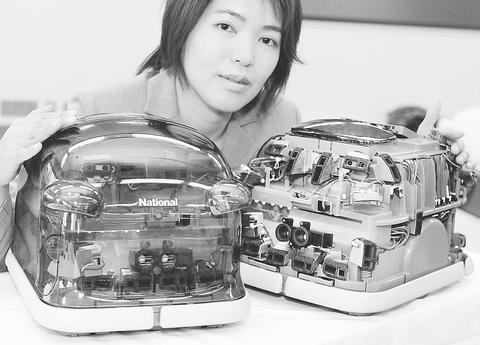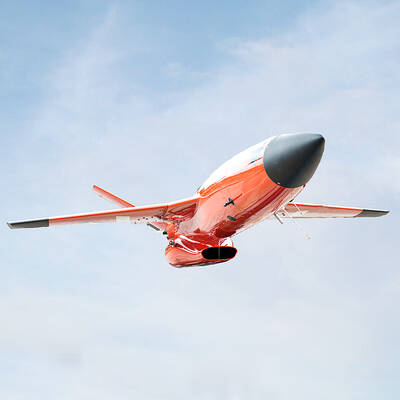The vacuum-cleaning robot from Japanese electronics manufacturer Matsushita Electric Industrial Co still crashes into chair legs and leaves lots of corners unswept.
But the unnamed test model, shown to reporters yesterday, is set to go on sale in three years with a price tag of Japanese yen 500,000 (US$3,800), the Osaka-based company said.
That's a target price counting on technological developments over the next few years that should bring down costs, officials said. The cordless machine, slightly bigger than a basketball, required Japanese yen 200 million (US$1.5 million) of research costs.

PHOTO: AFP
The company, which makes the Panasonic brand, has no export plans for the robot.
Matsushita said its autonomous-control technology can be used in other housekeeping robots that can work as a security guard or a caretaker for children or the elderly when equipped with features like cameras and mobile connections.
Eye-like lights glowing in the front and the back, the vacuuming robot comes with 50 sonic, infrared and other types of sensors so it turns before running into walls and avoids falling off steps.
Running for 55 minutes on a single battery charge, it figures out the size of a room by circling around it once and then travels horizontally and vertically to crisscross through the room to vacuum 92 percent of the floor space, Matsushita said.
It can't clean the edges because it's designed to stop 15cm before a wall and other obstacles that are at least 3cm wide.
"We have long been tackling the automation of domestic chores," said Matsushita director Yoshitaka Hayashi. "Robots will someday guard against fires and burglary in homes while people are asleep."
In a demonstration at Matsushita's Tokyo office, the vacuuming robot inched around a set similar to a living room, avoiding cabinets and furniture but left large portions near walls untouched. A person would have to use a regular vacuum cleaner to do a more thorough job, Matsushita said.
The robot took about nine minutes to finish the task, but officials acknowledged a person could do it in about five minutes. The robot also needs more work because it can get stuck under chairs and tables, they said.
The robot is designed to suck things up more powerfully and slow down when traveling over dusty areas.
Several of the robots will be tested in Japanese homes starting in May.
A number of Japanese companies are selling and developing robots for homes, although the offerings from Sony Corp, for example, are strictly for entertainment. Matsushita has developed vacuuming robots for industrial use, but they weren't designed to dodge obstacles.
Japan leads the world in robot use, a nation that accounts for nearly half of the new robots installed worldwide in 2000, according to the UN.

‘WIN-WIN’: The Philippines, and central and eastern European countries are important potential drone cooperation partners, Minister of Foreign Affairs Lin Chia-lung said Minister of Foreign Affairs Lin Chia-lung (林佳龍) in an interview published yesterday confirmed that there are joint ventures between Taiwan and Poland in the drone industry. Lin made the remark in an exclusive interview with the Chinese-language Liberty Times (the Taipei Times’ sister paper). The government-backed Taiwan Excellence Drone International Business Opportunities Alliance and the Polish Chamber of Unmanned Systems on Wednesday last week signed a memorandum of understanding in Poland to develop a “non-China” supply chain for drones and work together on key technologies. Asked if Taiwan prioritized Poland among central and eastern European countries in drone collaboration, Lin

The Chien Feng IV (勁蜂, Mighty Hornet) loitering munition is on track to enter flight tests next month in connection with potential adoption by Taiwanese and US armed forces, a government source said yesterday. The kamikaze drone, which boasts a range of 1,000km, debuted at the Taipei Aerospace and Defense Technology Exhibition in September, the official said on condition of anonymity. The Chungshan Institute of Science and Technology and US-based Kratos Defense jointly developed the platform by leveraging the engine and airframe of the latter’s MQM-178 Firejet target drone, they said. The uncrewed aerial vehicle is designed to utilize an artificial intelligence computer

Renewed border fighting between Thailand and Cambodia showed no signs of abating yesterday, leaving hundreds of thousands of displaced people in both countries living in strained conditions as more flooded into temporary shelters. Reporters on the Thai side of the border heard sounds of outgoing, indirect fire yesterday. About 400,000 people have been evacuated from affected areas in Thailand and about 700 schools closed while fighting was ongoing in four border provinces, said Thai Rear Admiral Surasant Kongsiri, a spokesman for the military. Cambodia evacuated more than 127,000 villagers and closed hundreds of schools, the Thai Ministry of Defense said. Thailand’s military announced that

CABINET APPROVAL: People seeking assisted reproduction must be assessed to determine whether they would be adequate parents, the planned changes say Proposed amendments to the Assisted Reproduction Act (人工生殖法) advanced yesterday by the Executive Yuan would grant married lesbian couples and single women access to legal assisted reproductive services. The proposed revisions are “based on the fundamental principle of respecting women’s reproductive autonomy,” Cabinet spokesperson Michelle Lee (李慧芝) quoted Vice Premier Cheng Li-chiun (鄭麗君), who presided over a Cabinet meeting earlier yesterday, as saying at the briefing. The draft amendment would be submitted to the legislature for review. The Ministry of Health and Welfare, which proposed the amendments, said that experts on children’s rights, gender equality, law and medicine attended cross-disciplinary meetings, adding that